As someone who believes pineapples belong in EVERYTHING (yes, even on pizza - don't @ me!), discovering Pininyahang Manok was like finding my soul mate in Filipino cuisine. My lola would laugh at how I'd always sneak extra pineapple chunks into my bowl, but who could blame me?
That perfect marriage of creamy sauce and sweet-tangy pineapple with juicy chicken is basically what ulam dreams are made of. After countless attempts to recreate that nostalgic flavor from my childhood, I've finally perfected this pininyahang manok recipe that has my own family fighting over the last piece of chicken and requesting "extra sauce" for their rice.
Once you try this version of Pininyahang Manok, you'll understand why this dish has turned even my pinakamaselan na pamangkin into a certified pineapple lover.
Jump to:
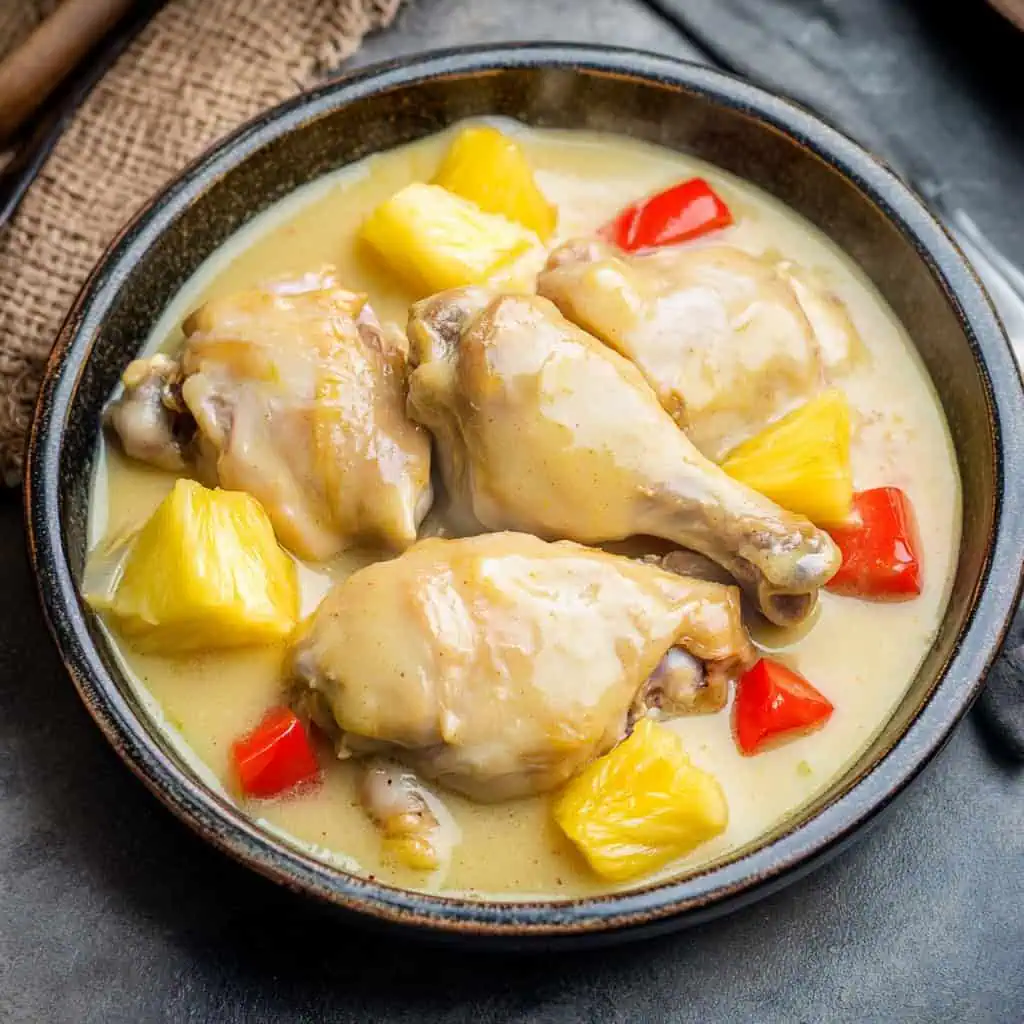
Why You'll Love This Recipe
- Perfect Balance: The creamy sauce with sweet-tangy pineapple creates an irresistible flavor combination
- One-Pan Wonder: Everything cooks in a single pan for easy cleanup
- Family Favorite: Kids and adults alike love this unique twist on chicken
- Versatile: Can be made ahead and freezes well
- Budget-Friendly: Uses simple ingredients available in any grocery store
- Forgiving Recipe: Easy to adjust and customize to your taste
Ingredients
This Pininyahang Manok recipe combines ingredients that create perfect harmony in every bite. The chicken provides a savory base while pineapple adds natural sweetness and tanginess that cuts through the richness of the cream.
Red bell peppers contribute color, sweetness, and a slight crunch, while garlic and onions create an aromatic foundation that enhances all other flavors. The pineapple juice tenderizes the chicken while forming the base of the sauce, and the cream transforms everything into a velvety, luxurious stew.
Each ingredient plays an essential role - from building flavor to creating texture - resulting in a balanced dish that captures the essence of Filipino comfort food with its signature sweet-savory profile.
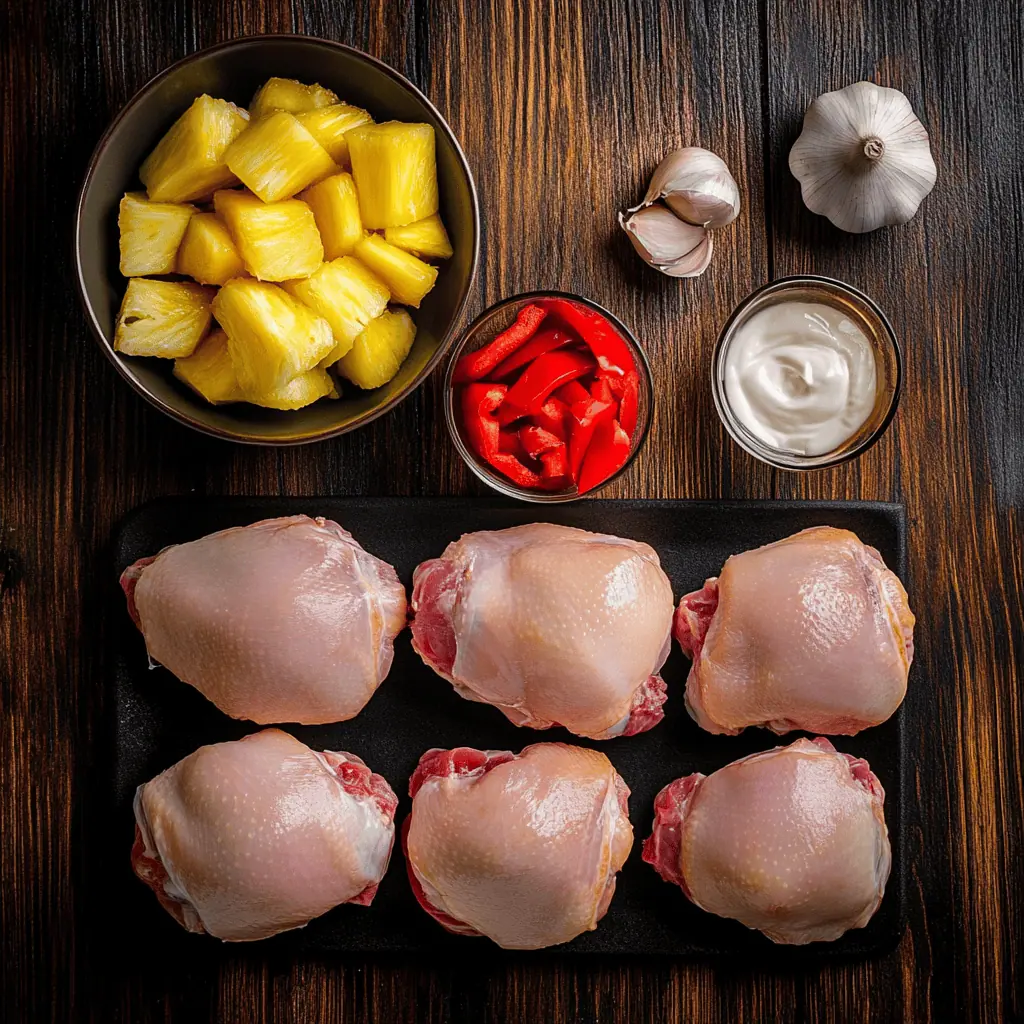
- 3 pounds chicken parts (preferably mix of thighs and drumsticks)
- 1 cup table cream or all-purpose cream
- 1 cup pineapple chunks
- 1 cup pineapple juice
- 1 medium red bell pepper, cut into chunks
- 1 medium onion, thinly sliced
- 3 cloves garlic, minced
- 1 tablespoon cooking oil
- Salt and pepper to taste
Equipment
- Large, deep skillet or Dutch oven: For browning chicken and holding all ingredients
- Sharp chef's knife: For cutting vegetables and trimming chicken
- Cutting board: Preferably separate ones for meat and vegetables
- Measuring cups and spoons: For accurate ingredient proportions
- Wooden spoon or silicone spatula: For stirring without scratching your pan
- Instant-read thermometer: For checking chicken doneness (optional but helpful)
- Tongs: For easily turning chicken pieces while browning
- Mixing bowls: For preparing ingredients before cooking
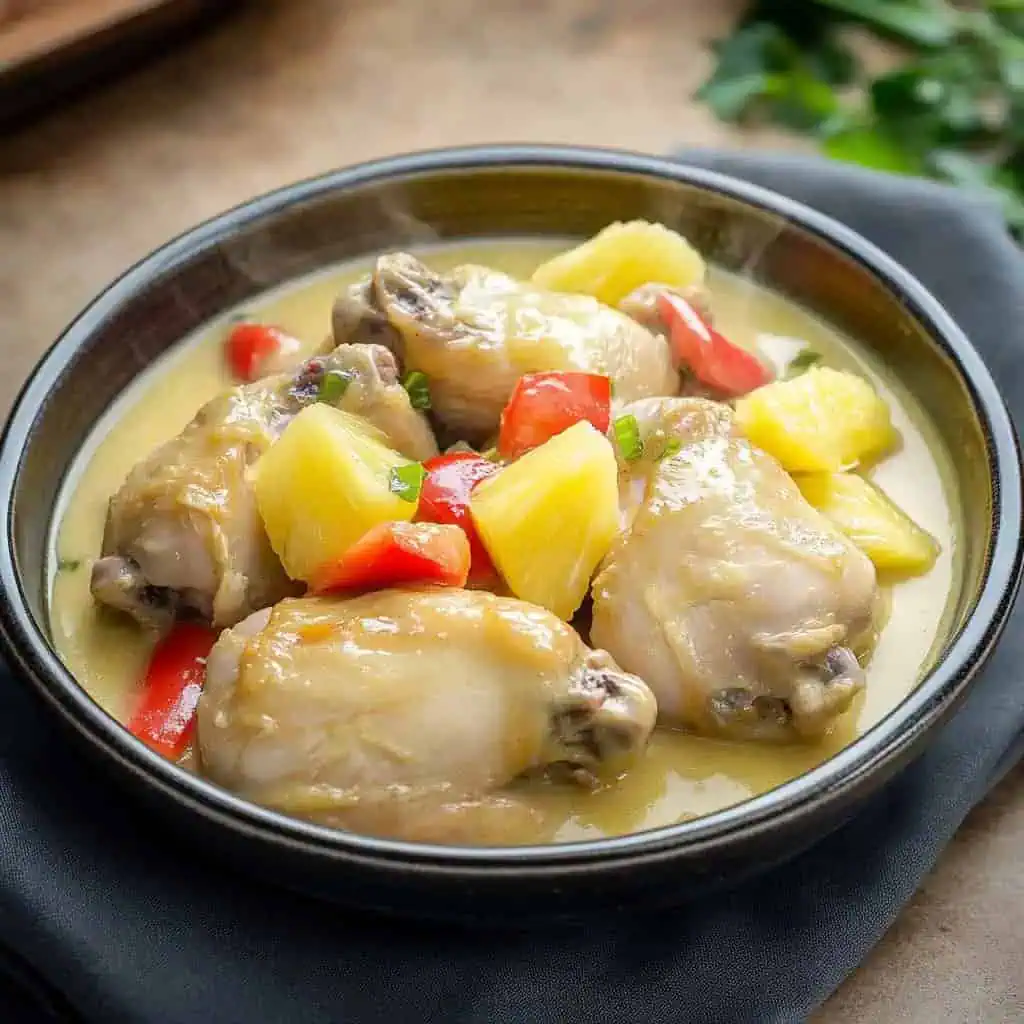
How To Make
- Preparation: Pat the chicken pieces dry with paper towels. Remove any excess moisture for better browning. Take the cream out of the refrigerator and let it come to room temperature (80°F) - this is crucial to prevent the sauce from curdling. Drain your pineapple chunks and save the juice. Cut the red bell pepper into 1-inch chunks and slice the onions thinly.
- Cook vegetables: Heat your large pan over medium heat. Add the cooking oil. Once hot, add the bell peppers and cook quickly for just 30 seconds. Remove the peppers and set aside. In the same pan, add your sliced onions and cook until translucent, about 3 minutes. Add the minced garlic and cook until fragrant, around 30 seconds.
- Brown chicken: Add chicken pieces to the pan. Brown them on all sides over medium-high heat, which should take about 5-7 minutes. Ensure each piece gets good color as this adds flavor. Pour in your reserved pineapple juice, scraping the bottom of the pan to release any browned bits.
- Simmer chicken: Bring the liquid to a boil, then lower the heat. Cover the pan and let the chicken simmer until tender and fully cooked, about 25-30 minutes. Check that the internal temperature reaches 165°F using a meat thermometer if you have one.
- Add pineapple and cream: Once the chicken is tender, add your pineapple chunks. Lower the heat further to very low – this is crucial for the next step. Gradually pour in your room-temperature cream while constantly stirring to prevent the sauce from curdling. Season with salt and pepper to taste.
- Finish the dish: Let the sauce simmer gently until it thickens enough to coat the back of a spoon. Add back your reserved bell peppers and let everything simmer together for a final 2-3 minutes.
- Rest and serve: Turn off the heat and let the dish rest for 5-10 minutes before serving. This allows the flavors to meld together and the sauce to thicken further. Serve your Pininyahang Manok hot over steamed rice.

Tips from Lola's Kitchen
Choose the Right Chicken
- Use bone-in pieces for richer flavor and juicier meat
- Keep skin on for extra richness and flavor in the sauce
- Try to use similar-sized pieces so they cook evenly
- Dark meat (thighs and drumsticks) stays juicier than breast meat
Perfect Cream Sauce
- Never boil the sauce after adding cream – this is the number one rule!
- Room temperature cream incorporates more smoothly than cold cream
- Stir constantly while simmering to prevent separation
- If your sauce is too thick, thin it with a little warm pineapple juice
- If your sauce is too thin, simmer longer without the lid
Flavor Enhancement
- Brown the chicken thoroughly for a deeper, more complex flavor
- Skim off any foam that rises to the surface during simmering
- Season in layers – add a little salt with the vegetables, again with the chicken, and finally adjust when the sauce is done
- A squeeze of calamansi or lemon juice just before serving brightens all the flavors
Traditional Serving Suggestions
- Serve over steaming white rice to soak up the delicious sauce
- Garlic rice (sinangag) adds an extra layer of flavor
- Fresh tomato slices on the side provide a refreshing contrast
- Pickled papaya (atchara) complements the creamy sauce with its tangy crunch
- For special occasions, line serving platters with banana leaves for an authentic Filipino presentation
Substitutions
- Cream: Coconut milk (for a tropical twist), evaporated milk (for a lighter version), or even a combination of milk and melted butter in a pinch
- Chicken: Pork chunks work beautifully, or try firm tofu for a vegetarian version
- Bell Peppers: Carrots add sweetness and color, or potatoes absorb the flavors wonderfully
- Canned Pineapple: Use 2 cups fresh pineapple chunks plus 1 cup water or pineapple juice
- Cooking Oil: Any neutral oil works well – canola, vegetable, or even coconut oil for a subtle tropical note
Troubleshooting
Curdled Sauce
- Problem: Heat was too high after adding cream, or cream was too cold
- Solution: Lower heat immediately, whisk continuously, and next time ensure cream is at room temperature before adding
- Prevention: Never let the sauce boil after adding cream and always use room temperature cream
Tough Chicken
- Problem: Cooked too quickly at high heat or not simmered long enough
- Solution: Continue simmering on lower heat until tender, adding a little more liquid if needed
- Prevention: Maintain a gentle simmer and be patient – good chicken stew requires time
Watery Sauce
- Problem: Too much liquid or not enough reduction time
- Solution: Remove chicken temporarily and simmer sauce uncovered until it reduces to desired consistency
- Prevention: Allow proper reduction time and don't rush the final simmering stage
Bland Flavor
- Problem: Insufficient seasoning or browning
- Solution: Add salt gradually, perhaps a dash of fish sauce (patis), or a little chicken bouillon
- Prevention: Brown chicken well at the beginning and season in layers throughout cooking
Storage & Reheating
Refrigerator
- Store in an airtight container for 3-4 days
- The flavor often improves after a day as ingredients meld together
Freezer
- Freeze for up to 3 months in freezer-safe containers
- For best results, freeze without cream and add fresh cream when reheating
- If freezing with cream, expect some texture changes upon thawing
Reheating
- Stovetop (Preferred Method): Reheat over low heat, stirring occasionally to prevent scorching
- Microwave: Use 50% power and heat in 2-minute intervals, stirring between each interval
- Add fresh herbs: Sprinkle with fresh herbs after reheating for renewed flavor
- If sauce has thickened too much during storage, add a splash of cream or chicken broth
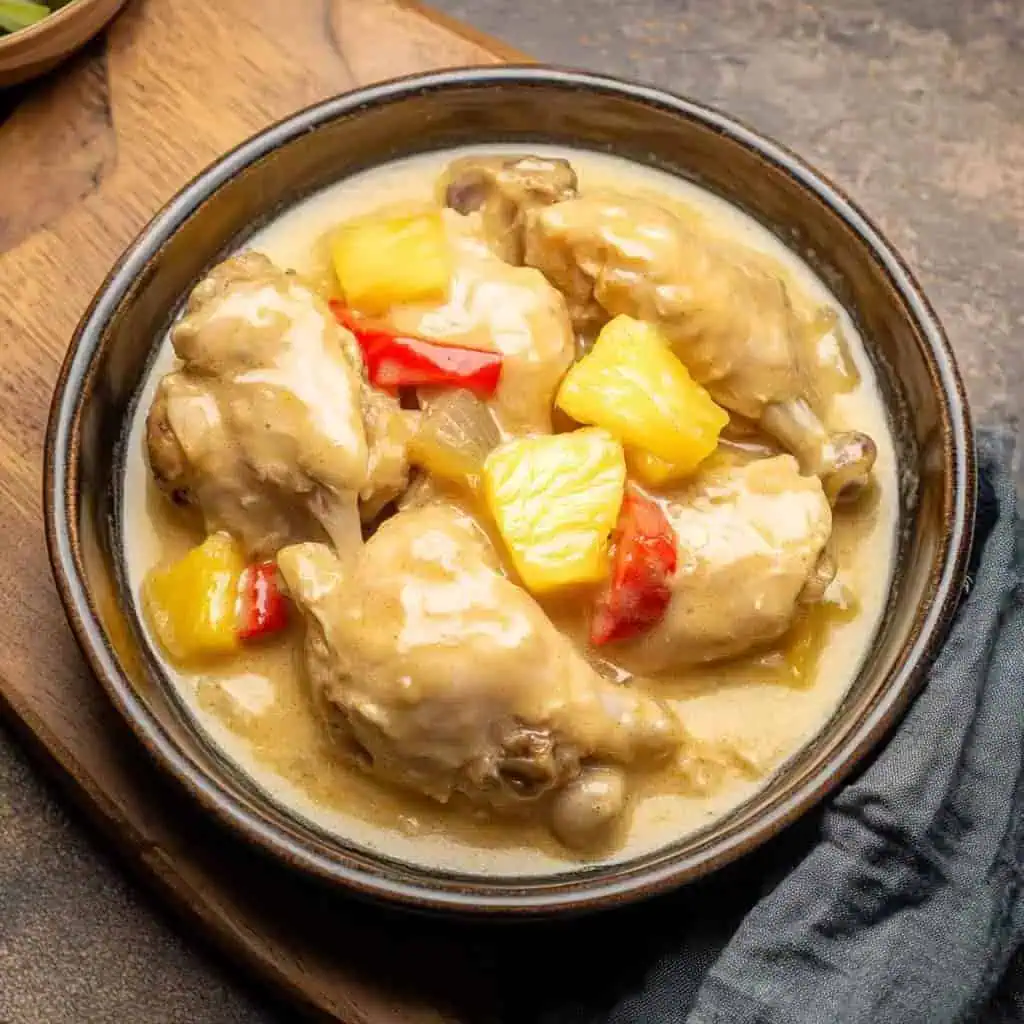
FAQ
Can I use chicken breast instead of thighs and drumsticks?
Yes, you can use chicken breast, but reduce the cooking time to avoid drying out the meat. Boneless chicken breasts will cook in about 15-20 minutes. For best results, cut them into even-sized pieces.
Why did my sauce curdle or separate?
High heat or boiling after adding cream causes curdling. Always ensure your cream is at room temperature before adding, add it gradually while stirring constantly, and keep the heat very low after adding cream.
Can I make this dish ahead of time for a party?
Yes! In fact, Pininyahang Manok often tastes better the next day as the flavors have time to meld. For best results, prepare everything except the cream, then reheat gently and add fresh cream just before serving.
Is this recipe freezer-friendly?
Yes, but for best results, freeze without the cream and add fresh cream when reheating. If you must freeze with cream, be aware that the texture might change slightly upon thawing and reheating.
My family doesn't like bell peppers. What can I use instead?
Carrots make an excellent substitute and add natural sweetness. You could also use green peas, corn, or even broccoli florets added in the final 5 minutes of cooking.
Can I use fresh pineapple instead of canned?
Absolutely! Fresh pineapple adds wonderful flavor. Use 2 cups of fresh pineapple chunks and create your own "juice" by blending some pineapple pieces with a cup of water, or use store-bought pineapple juice.
How do I know when the chicken is fully cooked?
The safest method is using an instant-read thermometer, which should register 165°F (74°C) when inserted into the thickest part of the chicken without touching bone. Without a thermometer, ensure the meat is no longer pink and the juices run clear when pierced.
Can I make a dairy-free version of this dish?
Yes! Substitute the cream with coconut milk for a dairy-free version that still maintains a creamy texture. This variation is actually quite popular in some regions of the Philippines.
Related
Looking for other recipes like this? Try these:
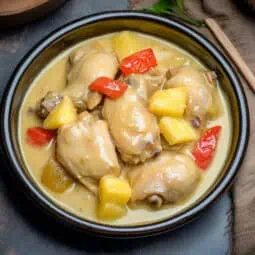
Pininyahang Manok (Filipino Creamy Pineapple Chicken)
Ingredients
- 3 pounds chicken parts manok - preferably mix of thighs and drumsticks
- 1 cup table cream or all-purpose cream krema
- 1 cup pineapple chunks pinya
- 1 cup pineapple juice katas ng pinya
- 1 medium red bell pepper pulang siling pangsigang, cut into chunks
- 1 medium onion sibuyas, thinly sliced
- 3 cloves garlic bawang, minced
- 1 tablespoon cooking oil
- Salt and pepper asin at paminta, to taste
Instructions
- Start by patting the chicken pieces dry with paper towels (punasan ng paper towels ang manok). Remove any excess moisture for better browning. Take the cream out of the refrigerator and let it come to room temperature (27°C/80°F) - ito ay mahalaga para hindi mag-curdle ang sauce. While waiting, drain your pineapple chunks and save the juice for later. Prepare your vegetables by cutting the red bell pepper into 1-inch chunks and slice the onions thinly.
- Heat your large pan or kawali over medium heat (170°C/340°F). Once hot, add the cooking oil. When the oil begins to shimmer, add the bell peppers and cook quickly for just 30 seconds. Remove the peppers and set aside – ilagay muna sa isang mangkok. In the same pan, add your sliced onions and cook until they become translucent (malinaw), about 3 minutes. Add the minced garlic (dinurog na bawang) and cook until you can smell its aroma (hanggang mabango), around 30 seconds.
- Now add your chicken pieces to the pan. Brown them on all sides over medium-high heat (190°C/375°F), which should take about 5-7 minutes. Make sure each piece gets good color as this adds flavor (mas lalasa ang manok). Pour in your reserved pineapple juice, scraping the bottom of the pan to release any browned bits – these add extra flavor to your sauce.
- Bring the liquid to a boil, then lower the heat (145°C/295°F). Cover the pan and let the chicken simmer until tender and fully cooked (luto at malambot), about 25-30 minutes. Check that the internal temperature reaches 74°C/165°F using a meat thermometer if you have one.
- Once the chicken is tender, add your pineapple chunks (pinya). Lower the heat further to very low (130°C/265°F) – this is crucial for the next step. Gradually pour in your room-temperature cream while constantly stirring (habang hinahalo). This prevents the sauce from curdling. Season with salt and pepper to taste (timplahan ng asin at paminta).
- Let the sauce simmer gently until it thickens enough to coat the back of a spoon (hanggang lumapot ang sarsa) – dragging your finger across the spoon should leave a clear line. Add back your reserved bell peppers and let everything simmer together for a final 2-3 minutes.
- Turn off the heat and let the dish rest for 5-10 minutes before serving (palamiginin ng konti bago ihain). This allows the flavors to meld together and the sauce to thicken further. Serve your Pininyahang Manok hot over steamed rice (mainit na kanin).
- For storage: Let the dish cool completely before transferring to an airtight container. It will keep in the refrigerator for 3-4 days. When reheating, do so gently over low heat (145°C/295°F) to prevent the sauce from breaking. If frozen (good for up to 3 months), thaw overnight in the refrigerator before reheating.
- Time-saving tip: You can prepare the dish up to the point before adding the cream, then refrigerate. When ready to serve, reheat gently and add fresh cream to finish.
- For best results: Always use room temperature cream, never boil the sauce after adding cream, and adjust the thickness with reserved pineapple juice if needed. If your sauce becomes too thick while standing, thin it with a little warm pineapple juice, stirring gently over low heat.
Tips from Lola's Kitchen
- Choose the Right Chicken
- Use bone-in pieces for better flavor
- Keep skin on for richness
- Similar-sized pieces cook evenly
- Perfect Cream Sauce
- Never boil after adding cream
- Stir constantly while simmering
- If too thick, thin with pineapple juice
- If too thin, simmer longer
- Flavor Enhancement
- Brown chicken well for deeper flavor
- Don't skip skimming the foam
- Season in layers
Nutrition
The Story Behind Pininyahang Manok (Filipino Creamy Pineapple Chicken)
Like many beloved Filipino recipes, Pininyahang Manok (Filipino Pineapple Chicken) tells a fascinating story of cultural fusion and culinary creativity. While the exact origins aren't documented in history books, this creamy pineapple chicken dish emerged during the American colonial period in the Philippines, when canned pineapples became readily available in local markets. What started as a creative way to make chicken more exciting has evolved into one of the most cherished ulam recipes passed down through generations of Filipino families.
The genius of Pininyahang Manok lies in how it perfectly captures the Filipino palate's love for creamy, sweet-savory combinations. Unlike its coconut milk-based cousins like Ginataang Manok or Chicken Curry, this dish uniquely combines all-purpose cream with the tropical sweetness of pineapples, creating that distinctive golden sauce that Filipinos can't resist. It's a perfect example of how our local cuisine expertly balances contrasting flavors – the richness of cream, the tanginess of pineapple, and the savory depth of chicken all harmonizing in one pot.
In every Filipino household, you'll find a different version of this recipe. Some families swear by using fresh pineapples from Tagaytay or Bukidnon for that extra sweet-tart flavor, while others prefer the convenience and consistent taste of canned pineapples. Some make it extra creamy for special occasions, while others keep it lighter for everyday meals. My own version combines the best tips I've learned from my mother, my mother-in-law, and years of Sunday lunch experiments that have earned this dish its permanent spot in our family's weekly menu rotation.
What makes Pininyahang Manok truly special isn't just its unique flavor profile – it's how it represents the Filipino talent for adaptation and innovation in cooking. From simple family dinners to birthday celebrations and potluck parties, this dish has become a modern Filipino classic that proves how our cuisine continues to evolve while maintaining its distinct identity. Whether served with steaming white rice on an ordinary weekday or presented as a party centerpiece alongside other Filipino favorites, Pininyahang Manok remains a testament to the creativity and warmth of Filipino home cooking.
Remember: Perfect pininyahang manok isn't just about the ingredients—it's about achieving that ideal sauce consistency where the cream doesn't overpower the pineapple's brightness, and the chicken remains tender while soaking up all those wonderful flavors.










Comments
No Comments